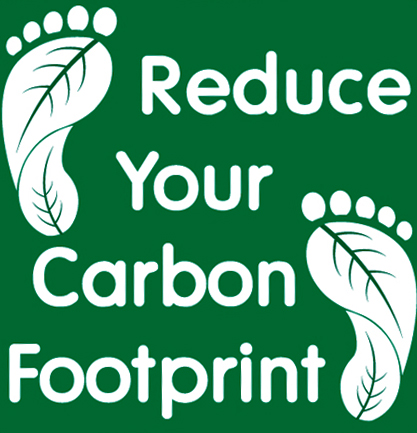
by Kim Adelson – It’s New Year’s resolution time! And I am betting that if you are reading this article you care about our environment. There are many ways most of us contribute to pollution – we use toxic chemicals to clean our houses, we waste water – but I am going to focus on two especially important ones in the coming year and here in this piece. First, since greenhouse gas emissions are the leading driver of climate change, I am challenging myself and I challenge you to reduce your carbon emissions in 2020.The average American annually produces about 16.6 metric tons of CO2, far above the global average (~4 metric tons) and well over what is needed to prevent the climate crisis. (If you’d like to calculate your own carbon footprint, I recommend the EPA’s calculator (carbon footprint calculator). My personal goal is to cut my carbon footprint by 5% this year: this might not seem like much, but if I can do it in 2020 and then again in 2021, 2022, 2023 and 2024, I will end up having cut my carbon production by 25%. The second change I’ll be working on is to severely limit my use of plastics. Most plastics don’t biodegrade and they also leach harmful chemicals into both soil and water. In addition, birds and other animals eat plastic goods when they mistake them for prey; they also become entangled in fishing line, balloon strings, and the like. Surely we can all find ways to cut down our carbon and plastic use!
Below I’ve provided a sampling of strategies to help you do these two things, and hopefully at least one and maybe several will resonate with you. Most of you probably already do a number of them, but I hope you can find a few that you can newly incorporate into your routine. Some are easy and you may feel you can manage to do them 90-100% of the time, while others are more difficult: please don’t ignore these, because doing them some of the time is better than not doing them at all. I challenge you to commit to working on, consistently or as much as you can, at least 1 (and ideally several!) of the strategies that seem most feasible for you.
In the Kitchen
- Stop using plastic wrap. Switch to reusable silicone stretch lids (I have, and I love them!).
- Stop using plastic baggies. Again, there are reusable choices, such as glass bowls and reusable wrappings.
- Avoid buying food – and other products – wrapped in plastic clamshells, Styrofoam, or shrink wrap. Instead purchase products packaged in cardboard or glass.
- Buy in bulk and bring your own refillable containers. I have just purchased reusable mesh bags for produce and dry goods.
- Avoid buying single-serving-sized items. Four-ounce containers of applesauce or yogurt and such are convenient but require much more packaging than a large container from which you can dole out your own servings. In general, large size items waste fewer packaging resources than smaller size items, and this holds for shampoos, laundry detergent, and many other non-food products as well as for food.
- Bring your own canvas totes when you go shopping and save some trees.
- Opt for metal and bamboo eating utensils and forego plastic ones. This goes for straws as well, of course.
- Roll up your sleeves and wash dishes rather than using paper plates and paper or plastic cups at home, even when throwing a party.
- Buy a travel mug and use it, rather than a plastic or a paper cup, when you go to your favorite coffee bar.
- Ditch disposable plastic water bottles. Buy a nice BPA-free one and carry it with you.
- Bring a Pyrex container with you when you dine out and have the waitperson put your leftovers in it rather than in Styrofoam or plastic. Beside reducing plastic waste, you will avoid the risk of harmful chemicals leaching into your food.
- Reduce your meat consumption. Eat more whole-grains and produce and less meat. Select fish, chicken, and pork more often than beef. Most of the Amazon’s deforestation is attributable to beef production, cows require lots of water and feed, and they produce large amounts of methane. Go vegetarian one or two more days a week than you usually do, and you will help the planet and raise the odds that you will avoid heart disease.
Travel/Commuting
- Bike and walk more. This is a triple winner, as doing so saves money, doesn’t involve a fossil fuel, and gives you exercise. It’s unlikely that you will entirely give up your car, but can you reduce your driving mileage by 5% this year? Try bundling errands, or work a dedicated “no driving” day into your weekly schedule. (Or work an additional one in if you already don’t drive each day.)
- Take public transit. Buses are by far the most energy efficient way to commute short and moderate distances. This is true whether one looks at theoretical energy usage (all seats filled) or actual usage. Full buses use 1/3-1/2 the energy of cars if every seat is taken in both the cars and the buses; buses, based on actual ridership, use about 40-50% of the energy of cars (which average roughly 2 passengers). Long, full trains use less energy/passenger than cars, but are often half empty in this country and have relatively few cars, which mutes their benefits in the U.S; still, they remain considerably more energy efficient than cars. Bus and train travel are safer than car travel as well.
- Forego one airplane flight this year. While airplanes are not always as energy inefficient as many people think they are (especially when compared to driving for very long trips), there is no doubting that they spew their fumes directly into the upper atmosphere where they do more damage than the same gases would at lower latitudes.
- When you do fly, make the most energy efficient choices that you can. Long haul flights are more energy efficient than shorter ones; i.e. don’t fly to Spokane. Choose nonstop flights when you can: taxi-ing, take off, and landing use many times the energy of cruising at altitude, and so the more of these you do, the higher your carbon output.
- Buy carbon offsets for your flying and driving, or even for your total carbon usage. There are numerous online calculators that let you determine how much green house gas you are pumping into the atmosphere. “Buying a carbon offset” means donating money to some group that will use your funds in such a way as to reduce the carbon in the atmosphere. The choices are incredibly varied: planting trees, capturing a landfill’s carbon emissions, donating to a charity that helps farmers reduce greenhouse gas production, augmenting a solar energy facility, etc. How much money are we talking about? It costs about $19 to offset the carbon I use flying from SeaTac to LaGuardia in New York to visit my family. It costs roughly $40-$90 for me to offset a year’s driving in my Subaru Legacy, depending upon which initiatives I support.
- Don’t insist that your online purchases arrive in two days. In order to get you that new toaster so quickly, online retailers are forced to ship more items by air rather than by ground. Also, they usually need to employ less efficient delivery routes and to make more trips than they would otherwise need to. Help them to reduce their carbon footprints by being patient.
Miscellaneous Things to Do at Home
- Insulate your home and seal your windows during the colder months.This saves money as well as reducing gas or electricity use.
- Replace incandescent bulbs with more energy efficient choices, such as LEDs. LED bulbs use only about 10% of the energy as incandescent bulbs, and although initially more expensive they have a much longer lifespan. Compact fluorescent bulbs use about 25% of the energy as incandescents. According to the EPA, if every household in America replaced just one incandescent light with a more efficient choice, we would save enough energy to power 3 million homes for an entire year.
- Turn down your thermostat when you are away and place your water heater in “vacation” mode. Why heat what you are not going to use?
- Unplug appliances and devices when you’re not using them. Many drain energy even when “off”.
- Do cold water laundries whenever possible. You’ll save energy and your clothes will not fade as quickly.
- In the winter, open your curtains on sunny days to let heat in and close them at night to help keep it trapped inside. OK, so we don’t have many sunny winter days here, but closing curtains at night really does help hold heat in, whatever the cloud cover.
- Shut lights when you leave a room.
- Turn your thermostat down a degree or two in the winter. Invest in sweaters and sweatshirts and stay just as warm.
- Wash your clothes only when they truly need it. If airing them out will suffice, do it and save the energy used by your washing machine and dryer and the chemicals in your laundry detergent.
- Hang dry your clothes during our warmer months.
- Purchase energy-efficient appliances when yours need to be replaced.
- Buy clothing made of cotton and wool, not synthetics. Polyester, nylon, and other synthetic fibers are, in fact, plastics. Worse, we now know that they shed hundreds of thousands of microfibers each and every time you wash them and that many of these microfilaments eventually end up in the ocean. Ultimately, they are eaten by marine organisms and become part of the food chain.
- Buy gently used items instead of new ones. Extending a product’s life is a very energy and resource efficient thing to do.
Again, I urge you to implement a few of these practices. They all boil down to reuse, recycle, and reduce. I’ll let you know how I did in my December article next year. Happy holidays!







